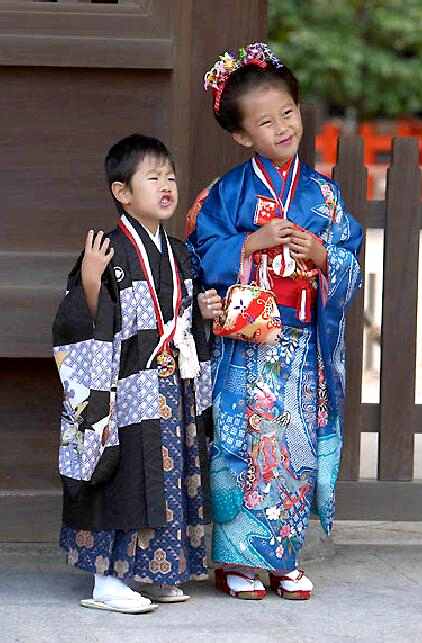
Japanese Holidays: Sichi-go-san--7-5-3 Day (November 15)

Figure 1.-- Children commonly dress up in traditional costumes for Shichigosan. This is the celebration when children turn celebrates the 7-5-3 (sichi-go-san) festival for children who have just or will soon turn 3, 5 and 7 years old. Presumably the boy here is 5 and the girl 7 years old.
|
Children commonly dress up for Shichigosan. This is the celebration when children turn celebrates the 7-5-3 (sichi-go-san) festival for children who have just or will soon turn 3, 5 and 7 years old. The official day for the festival is November 15. The girls dress in brilliantly colored kimono and the boys in elaborate pleated skirts known as hakama. The family then go to the local Shinto shrine. The 7-5-3 ages are what the adults see as critical ages in a child's development. Parents thus take their children that age to the Shinto shries to offer thanks and for future blessings. They may also go to Buddist temples, depending on the family's orientation. Young children in Japan were regarded as gifts of God until age 7 at which time they become normal human beings. Tis probably played into the age choices in Shichigosan. For the girl, age 3 marked the age that her hair will be put up in an adult-like manner for the first time. When she reaches age 7, she is given her first obi, the silk sash to be worn with kimono. For the boys, 5-year old is the age they are given their first hakama. The children also receive a bag of candy to celebrate the holiday. There are many family snapshots as well as formal studio portraits taken for the event.
The Holiday
Sichigosan is a destinctive Japanese celebration. It is the celebration when children turn celebrates the 7-5-3 (sichi-go-san) festival for children who have just or will soon turn 3, 5 and 7 years old. I am not sure when the Japanese first began celebrating this holiday. The official day for the festival is November 15.
Celebration
Many families commonly go to the local Shinto shrine. I am not entirely sure why these three ages were chosen. Parents take their children at the 7-5-3 age to the Shinto shries to offer thanks and for future blessings. They may also go to Buddist temples, depending on the family's religious orientation.
Ages
The 7-5-3 ages are what the adults see as critical ages in a child's development. Young children in Japan were regarded as gifts of God until age 7 at which time they become normal human beings. This probably played into the age choices in Shichigosan.
Candy Sack
The children also receive a bag of candy to celebrate the holiday. This alone makes the holidy a big hit for the children. The candy sack seems to be always a long narrow one with writing. I'm not sure what the writing says. It is a little difficult from the available images to tell how common the candy sacks are, but we suspect that most children get them.
Portraits
As the children are all dressed up for this special day and the family commonly goes to shrines and temples, it is a perfect time for photography. There are many family snapshots as well as formal studio portraits taken for the special event.
Costuming is an important part of Sichigosan. Children commonly dress up for Shichigosan. Young children love to dress up in costumes. Even boys at these ages enjoy it. Many children are dressed upin tradotional costumes. Some childre wear their best western-style suits and dresses. The girls might dress in brilliantly colored kimono and the boys in elaborate pleated skirts known as hakama. For the girl, age 3 marked the age that her hair will be put up in an adult-like manner for the first time. When she reaches age 7, she is given her first obi, the silk sash to be worn with kimono. For the boys, 5-year old is the age they are given their first hakama. We are not sure why some parents dress up the children in Western clothes rather than traditional outfits, but believe that the traditional clothes have become much more popular.
HBC

Navigate the Boys' Historical Clothing Web Site:
[Introduction]
[Activities]
[Biographies]
[Chronology]
[Clothing styles]
[Countries]
[Bibliographies]
[Contributions]
[FAQs]
[Glossary]
[Satellite sites]
[Tools]
[Boys' Clothing Home]
Navigate the Boys' Historical Clothing Japanese pages:
[Return to the Main Japanese folk costume holiday page]
[Return to the Main Japanese holiday page]
[Return to the Main Japanese activities page]
[Choirs]
[Department store catalogs]
[Monarchy]
[Music recitals]
[Scouts]
[School uniforms]
Created: 11:08 PM 10/7/2006
Last updated: 4:14 PM 10/11/2006



